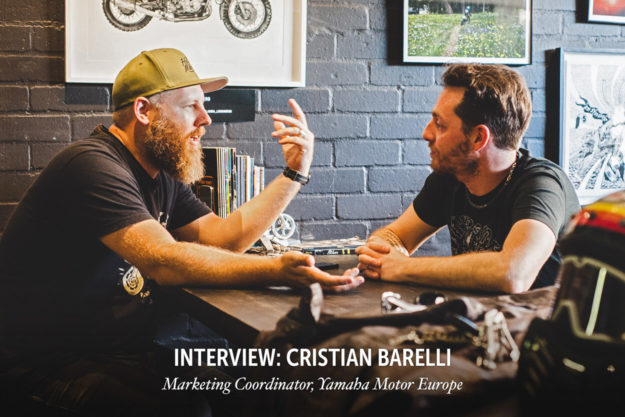
Over the past couple of years, no manufacturer has commissioned more custom bikes than Yamaha Motor Europe. The Yard Built program has given us plenty of eye candy, and Yamaha was the first OEM to invite Bike EXIF to a new model launch—that of the XSR700.
The XSR700 (and its big brother the XSR900, which I rode shortly afterwards) was a daring move by the Japanese marque. The XSRs are ‘heritage’ bikes targeted at the cafe racer crowd, but they’re built on unashamedly modern platforms. I loved the XSR700 and 900, and so did most of the motorcycle press, but our readers were divided—many criticizing their styling.

I caught up with Yamaha Motor Europe Marketing Coordinator, Cristian Barelli, in Cape Town recently. The 35-year-old Italian lives in Lombardy, but commutes to Yamaha’s office in Amsterdam during the week.
We talked about the influence of the custom scene, the development of the XSR platform, and where he reckons the scene is headed.
Wes: You were just saying how you have friends who had no interest in motorcycles a couple of years ago, which are now interested. Is that partly because of the custom scene’s growth?
Christian: Yeah, it’s like this. We saw, some years ago, that people started to use old motorcycles—started to customize them—and then saw that there is potential. I did the same thing, because ten years ago I bought an old BMW, for myself. I had a lot of fun in the garage, customizing it, but then when I rode in the street it was an old bike—riding slow, no brakes at all. So I said, ‘Hmm, maybe I need something more fresh and new to ride,’ because I love to ride bikes, not only to show them off.
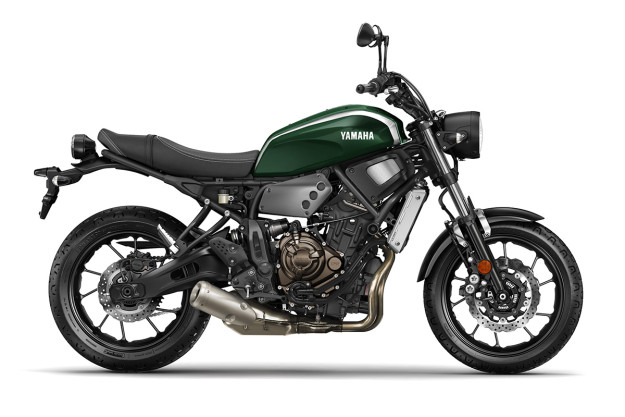
And then we saw that there is potential for new people. Because this scene is also fashion—and it’s not a bad thing that it is fashion, because young people have to be attracted in a way to something, no?
Twenty years ago there were powerful motorcycles with 150 horsepower that were cool, and people were starting out in this way. But it’s not like that any more. You don’t need that kind of power, because on the street you cannot use it all, and it’s dangerous, and you have lot of problems with the police. So it’s better to slow down a bit, and the scene is perfect for this.
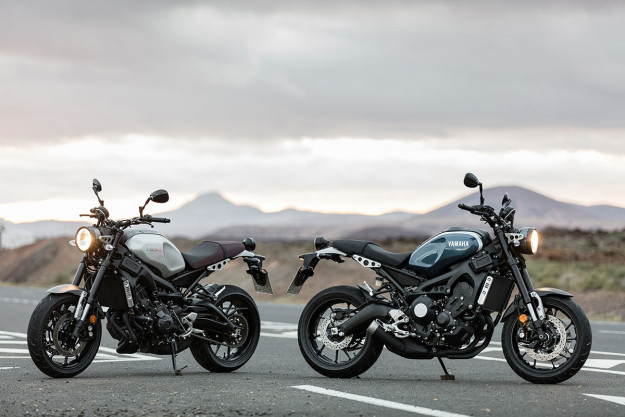
With the XSR700 and XSR900 (above), you took a very modern bike, and wrapped it in a package that was more modern classic than pure throwback. You took a lot of flack online for the bikes being so modern, and visually busy… but how did the market react?
In reality, the market is reacting very well, because we are selling well in Europe. I don’t know exactly in the US—because I don’t know the market—but also the US, with Shun [Miyazawa] there now, it’s starting to sell there too.
I can understand that the first time you see the bike, it’s not the typical custom bike. Because first of all it’s liquid cooled, so you have the radiator, you don’t have the classic engine and stuff like that. But it’s in our blood—we have performance in our company, we have technology, and we want to put these things in any product. We cannot stick to the past too much, but we stick, in a way, to how we made the bikes. For example, on the XSR the aluminum panel on the tank is something that gives you the feeling of a real bike; it’s not plastic.
And then for the rest, we have a great engine, we have great engineers that develop the frame and engine in a good way, so why not use this?
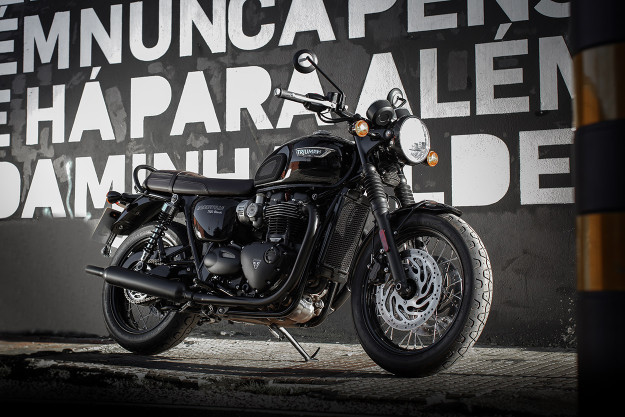
Looking at Triumph’s new modern classics (Bonneville T120 above), they’ve done well to build bikes that are liquid cooled, but look really old. But it took them a while to get there, and it’s a whole new platform. Was cost a factor when deciding to develop the XSR platform on the existing MT platform?
It’s also part of the project, because at the moment motorcycle market is not like ten years ago. Everybody’s selling less and less motorcycles. So it’s necessary also, from a business point of view, to have this business approach.
You cannot start a new bike from zero every time; develop a new engine, a new frame, and everything new. So in a way, you can call it a compromise—but in another way, when we developed the XSR900 and the XSR700, and before when we developed the MT platform, we already knew that we would use this platform for several units. So when we started the project, we started with this in mind; that we cannot develop only one bike, but we will develop many bikes, on the same platform. So in a way it’s a compromise, but in another way it’s tricky engineering.
To develop a bike from zero takes three, slash, four years. And now the market is so fast, that you have to catch the market when there is no market.
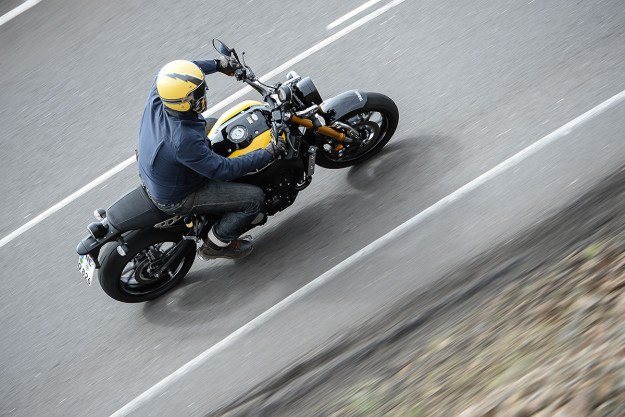
How long ago exactly did you start developing the XSR range?
When we started with the MT platform, we already knew that this base would be used for several models.
Did you know exactly what they would look like, or did you just have a rough idea?
Rough idea…
So you knew they would be heritage-focused?
Yes. We knew how to make it different—the bike—in a tricky way. We knew that the classic machine needed something different to our hyper-naked MT world, which is sharper, with more corners. But when we started the project, yes—since the beginning we knew that this platform would go onto several units.

Can we look forward to more heritage bikes on the MT platform?
Yes, we are thinking about something…
Can you say what?
I can tell you, but afterwards I have to kill you [laughs].
Well, I can guess; the classic scrambler scene is exploding again—is that something you’ve been thinking of?
Yes, of course we are thinking about this. Also because, with the Yard Built project, we saw that custom builders were starting to use this base to build something more scrambler, or off-roadish. And we always use Yard Built not only as a marketing tool, but also to see where the scene is going.
And then we were starting to see that many builders, like the Bunkers brothers last year, made the XSR700 in a scrambler-ish way (below). We said, ‘Is the scene going in this direction?’ And yes, of course we’re considering this input that we have from the scene, and from what’s happening around. So it’s something that we are considering.

So is Yard Built a big part of your product planning process? I know the SCR950 (below) took cues from various custom XV950s.
Our guys from product planning are always looking at the Yard Built bikes. For example, last year at Wheels and Waves, we had five people from product planning that came to see the scene. And when we release a Yard Built bike, they look at it.
It’s not that they take inspiration because they never thought about how to make a bike like that. But when product planning starts to develop a bike, they present different versions of the bike. Then we pick what we think is more sellable, in a way. But then you have all these different variations around, and when we make a Yard Built bike, and custom builders go in the same direction as one of our variations, for us it’s proof that the market is looking at that.
So we have the proof to go to management and say ‘OK, we proposed this, the custom builder did this, that means the people want this, so we can make it.’

Yard Built is possibly the custom scene’s most prolific OEM custom program, how did you get here?
Originally—before it was called Yard Built—we started with the Hyper Modified project, if you remember, in 2011 probably. The first one was on the VMAX, with Roland Sands, Lazareth (below) and Markus Waltz.
I remember, because at that time I worked at Yamaha Italy, and I was taking care of this segment. We were in EICMA, with a dedicated booth in the custom area. And I remember that we were almost the first company to do it like this. All the people around were custom builders looking at us: “What the fuck are you doing here? You are Yamaha!” Yes!
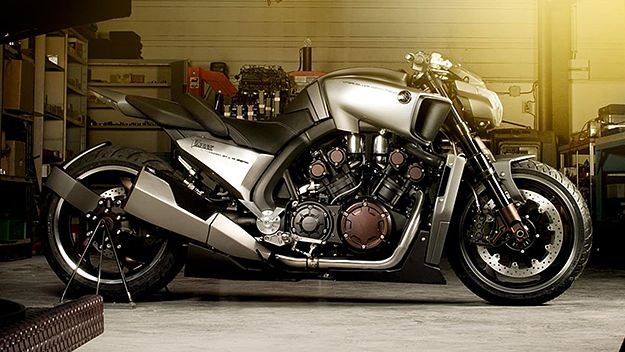
Then the year after, we did the same project with the TMAX, and then we built up the Yard Built story that has become bigger and bigger. For us it’s quite important, not only for marketing purposes, but also to be in contact with the people. Because when we start to talk with custom builders, we learn also from these people. Because these people are connected every day with the customers, with the people that are in this scene. So they know exactly what they want and where to go.
We also ‘steal’ some information from these builders, because they are in the scene every day. They are living out of it. We are in an office, we can see what’s happening, but the reality is different.

What is your arrangement with a builder on a Yard Built special?
It depends a lot on the project, depends a lot on who the builder is, and depends a lot on the ideas of the builder. Because when we start to talk, we start with ‘which bike do you want to use?’ We don’t want to force people towards a bike if they don’t feel it. Because the result will not be good enough.
So we start to talk: “What is your idea, what is your plan, which bike do you want to use?” And then we can start to talk together, and see how far they want to go—because one of the secrets of the Yard Built project is that the bike should stay with the stock frame and the stock engine. For us this is mandatory, because at the end we need to show what the bike can be for a customer. If it is too extreme, there is no point for us.
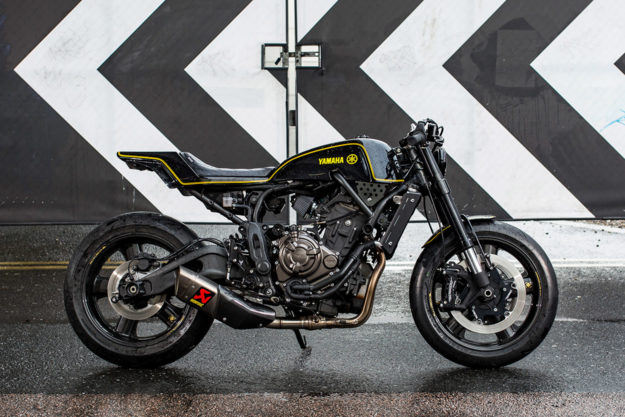
So we start to talk with them, to see, based on the frame and the engine, what they want to do. Based on this we can see how far they can go—if they need some budget from us, if they can do it without our support, and also sometimes we have some partners that can provide parts, and we have our accessory line-up that they can use for free.
Afterwards they keep the bike. Usually we borrow the bike for almost one year, to use it for shows and activities like that. Then the bike goes back to the builders—they can keep it, they can sell it, they can scrap it, they can do what they like.
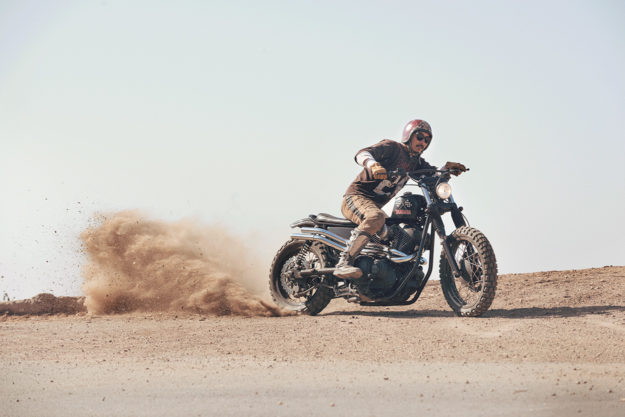
I know with some modern classics available today, you can go pretty far in terms of personalizing a bike, with simple changes. Is that the idea here?
Yes. That’s the point. If you remember with the XSR700, you can also remove the loop at the end of the frame, so that you can modify it easily without cutting, without losing any kind of warranty on the bike.
Also from a genuine parts point of view, we’re starting to go more deep into these kind of things. For the 700 you have two seats available as an option, and we have another one for the 900. So you can also start with plug and play things.
Especially for the new customer, it’s not easy to know what they want, to know where to go for what they want. So if they can start at the dealer and say ‘OK, I want this seat, I want this tank, blah, blah, blah,’ they can start to think. Then maybe in three months time you know your bike better, if you want to change the seat, no problem. You can go wherever you want and have your seat done.
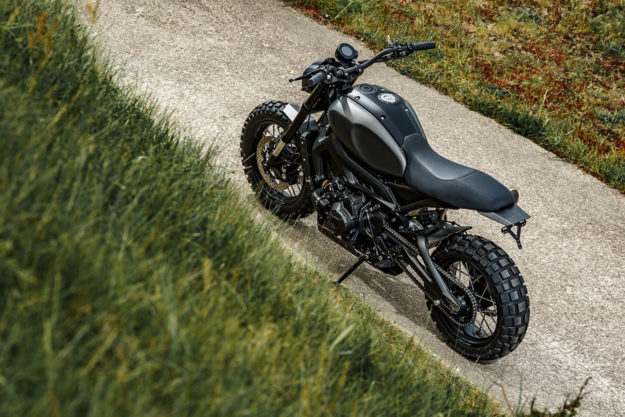
You’ve got builders like the Wrenchmonkees (above) and JVB-Moto selling bolt-on parts through suppliers like Kedo. How do you balance developing your own parts with supporting these guys?
The fact is, for us to develop accessories is a good thing—it’s a business. But we have a lot of strict rules on testing and stuff like that. For the builders it’s more easy to produce parts that, let’s say, let you modify the bike more than what we can do. We always say to the builders, ‘please, make these parts,’ because this gives appeal to the bikes. For example, JVB with the XSR700 (below)—he’s doing an amazing job and he’s selling a lot of kits. And we are happy about this, because they do something that we can not do, in a way.
Do you think that’s a sign of how the market’s changed? That customers are buying bikes based on their potential.
Yes, of course. This is another thing about the Yard Built project: we want to show what the bike can be. So when a customer goes into the dealer, he can see the bike—see the standard one—think of the Yard Built he saw, and based on this start to think what he can do with this bike. So for us, it is the perfect combination.
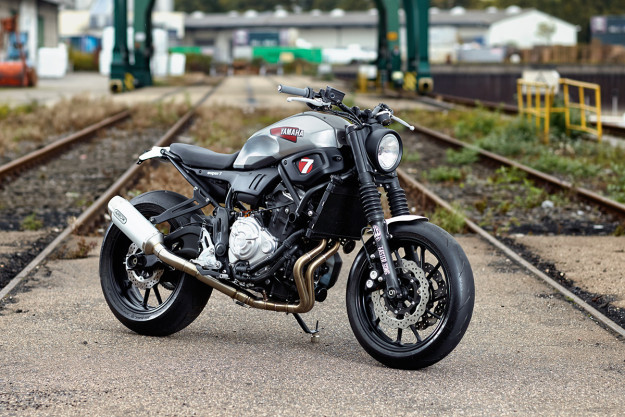
People traditionally think of Japanese bikes as functional rather than emotional, but Yamaha seems to be tapping into their heritage nicely. Is this driven by your European operation?
It’s a matter of co-operation between us, the US and Japan. In a way we have to say thank you to the crisis. Because ten years ago, when the global economic crisis arrived, our sales started to go down. We had a very tough moment, because we stopped all development for three years, and started only thinking about what do people want, and where do we want to go.
And we saw that there was a big difference between European brands that are more emotional—BMW, Ducati, Triumph—and all the Japanese brands, which are more related to reliability, value for money, and that’s it. So we said, ‘we have this background of performance and reliability, but we have to move on.’ Because we have to use this asset, and also move into the emotional side. This way we have the perfect combination, if we can add a bit of emotion on our roots that are about engineering and performance.
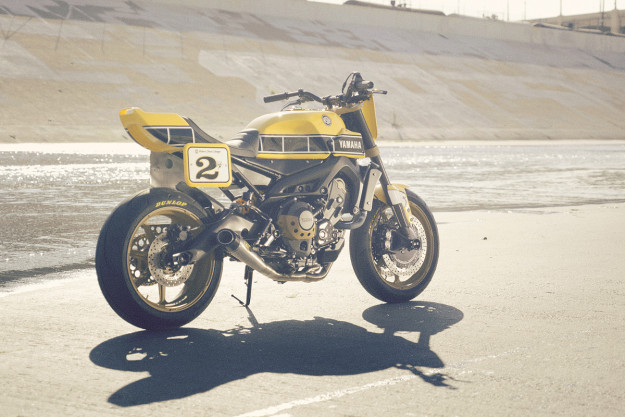
Of course the European market is one of the biggest markets. It’s also one of the most challenging markets, because customers are mature, so they know exactly what they want, and they’re always asking for something more, for less. So it’s quite challenging to work in this business in Europe.
But then at the end, after three years of thinking and thinking and thinking about it, we found a way to add a little bit of emotion onto our background. And I think we are doing well, because for example in Europe we are the leading brand, I think, that’s selling motorcycles.
Do you think value is still a hallmark of the Yamaha brand?
Yes. Because for us, we cannot charge the same as a European brand does. As a Japanese brand we are recognized to be—I don’t want to say cheap—but we are fair in price. And this for us is a strong point, we cannot compromise on this. We want to continue with this pricing strategy.
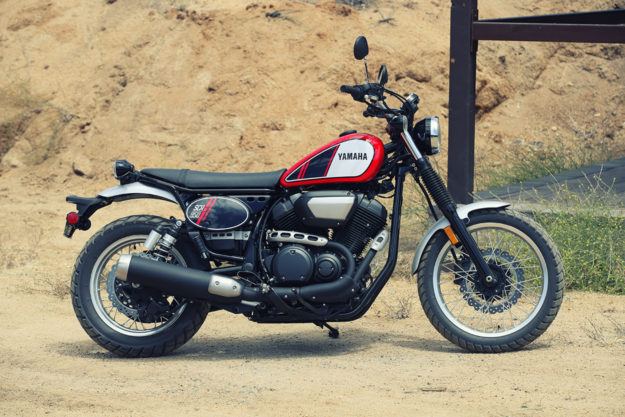
You’ve just launched the SCR950 (above) in Europe. How well do you think it’ll go down? It is a very American bike, style wise…
It is very American, but in a way… I think ‘SCR’ is the wrong name for this bike. We chose this name to give the feeling of the possibility to go almost everywhere. But the problem is that now when you call something ‘scrambler’ you point directly at Ducati in a way. Because they were good in taking the ownership of the name ‘Scrambler.’ They do it well.
Now if you call a bike ‘SCR’ and you compare it with the Scrambler, you can’t compare it, it’s a totally different bike. But in a way we’re catching the new trend of the Super Hooligans. Because now there is the big scene in the US where they are racing flat track race with Harleys (below) and Indians…heavy bikes!
![]()
Are you busy pushing into this at all?
At Wheels and Waves we’ll race with a SCR950. It’s a project that we are developing now with Marco Belli (below)—you know, the Di Traverso school? Super great guy, I like him so much. Last year at Wheels & Waves we did a great activity with him. He brought all the SR400s, and we invited people to race with this bike.
This year we want to do something different, and we want to do the same, so we say ‘OK Marco let’s do this: I give you an SCR950, make it a Super Hooligan bike, and somebody will ride it.’ (Probably Marco.) Because flat track is the next big thing in this scene. I like it personally, I did it a couple of times with Marco, and it’s super fun.
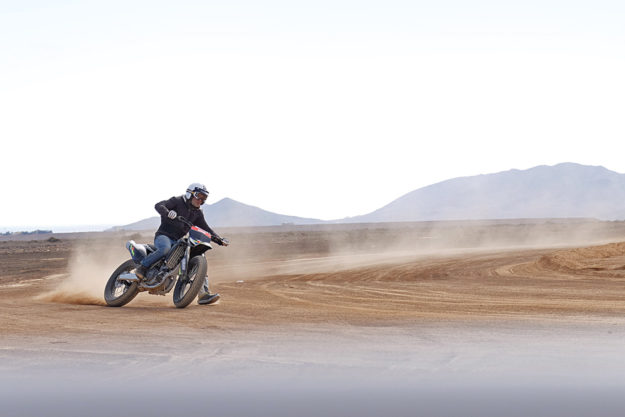
…like the flat track day we had at the XSR900 launch.
The first idea was to go to LA to do the press test. So I started to work on the idea of the press test, and I thought, “We are not far from Del Mar, why don’t we go to Del Mar with some bikes and do some flat track?” But it was a bit too complicated to organize everything, in terms of shipment and stuff like that, so we said, “OK, let’s go some other place.” And we chose Fuerteventura.
Then I went to the agency, to PJ [events manager Peter-Jan Willems], and I said, “PJ, I want to stick to the idea of the flat track, what do we do?’ And he said, “There are no flat track places in Fuerteventura.” I said, “OK. Let’s make one!” So we found a flat area, went there with machines, and we rolled it out and we did it.
Flat track is the easiest way to have fun, with non-professional bikes. Also all the journalists are—I don’t want to say professional riders—but they ride bikes every day, motocross, street bike, naked, stuff like that. But flat track puts everybody on the same level. Because if you are skilled in motocross, it doesn’t mean you are good at flat track. So all the journalists, at the same level, from zero.
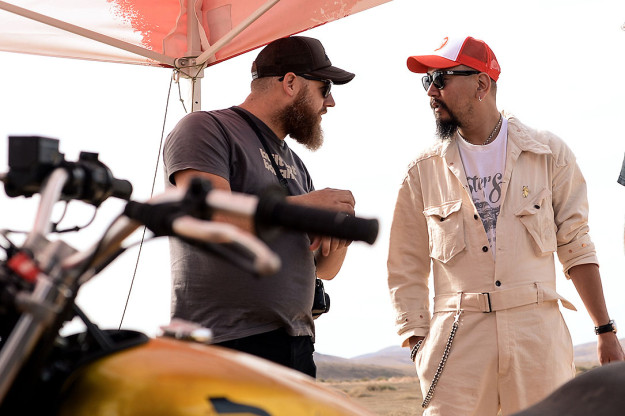
They came, they saw the SR400, they said ‘ah, but it’s a bullshit bike, less power, blah, blah.’ Then they took it…Yes! Everybody’s a fan! It’s perfect! Now Marco is doing very well with this bike, because they are doing a lot of training with people, there’s a lot of interest. So we said ‘OK Marco, let’s do an SCR950 in this way, and we see what happens at Wheels and Waves.’
And do you think there’s space in the future for more SCR950 variations?
Could be, yes.
The SCR950, MT-07 and MT-09 are your main heritage platforms right now. Are you planning to add more, like the MT-10 (below)?
That bike is perfect—if you ride it, you will love it. It’s super powerful—I’m not a guy that loves super powerful bikes, I’m quite scared about super powerful bikes—but the MT-10 is super cool.
So we talked about the opportunity to make maybe an XSR10, but then we were thinking maybe it’s better to look forward, to look at the young people, to look at something small for the newcomers.
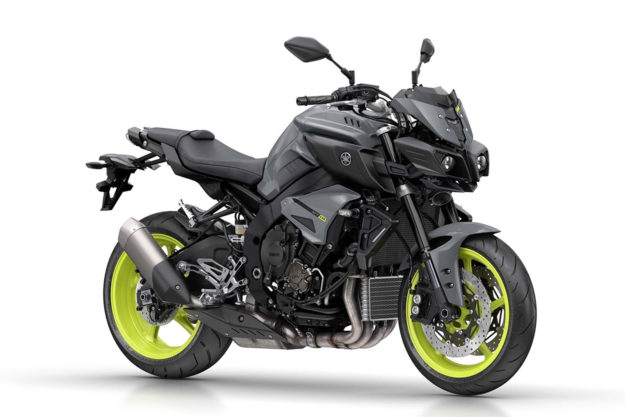
So maybe take the MT-03, and make an XSR3?
Maybe, that could be a good opportunity. Because as I told you before, this scene is growing, and it’s the only way where we can see that newcomers are coming in.
Have you seen your customer base get younger?
Yes. In this scene they are becoming younger.
Ducati’s new Desert Sled (below) is being hailed as a proper dual-sport bike, rather than a dressed up road bike. We’ve spoken before about how well the XSR700’s engine would lend itself to an off-roader. Do you think there’s a place for a retro scrambler that actually has a measure of off-road performance?
It’s getting interesting, this concept. If you look now at the scene, we started with the cafe racer, then we moved to the scrambler, but then now you can see clearly that the scrambler is not enough. They want to go more off-road. A scrambler is something that you do not go off-road with, but they want real dual-sports. And as I told you, some builders are starting to build off-road bikes—proper off-road bikes—on the base that we offer to them. So it’s becoming a trend.
Every time you’re starting from a niche, then this niche is growing, and you see that people are starting to go in different ways. One is of course off-road, and the other is racing. If you look at the Sultans of Sprint competition, or Glemseck 101, they are splitting it between performance on-road, and performance off-road. We have these two worlds, and we have to figure out where to go.
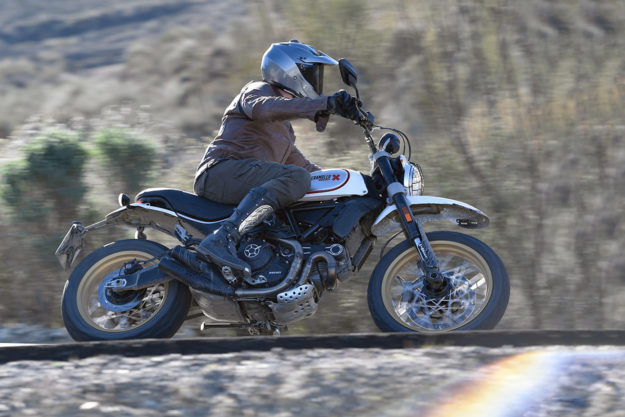
We’re seeing more and more builders customize modern, high performance bikes, rather than older bikes. Is this a sign of the times?
This is the normal process…you start with some old things, but old things need to be maintained, you need to have skills to maintain them. This was my case, when I bought my BMW. I was super happy to customize it in my garage, but when it went on the street, it’s all these different things—leakage of fuel everywhere, doesn’t brake, doesn’t go at all. So I said ‘OK, it’s cool, but I need something that can ride.’ That I can ride easily, that my girlfriend can come with me to the lake on, without any problems, because the bike doesn’t start. ‘Push me, push me please, baby.’
Or you are really, really into mechanic stuff, so you can say ‘I want an old bike because I can fix all the problems.’ But 10 percent of the people are like this, the other 90 percent are people that want to ride, they want to go to the bar, they want to ride out, but they don’t want to give a shit about mechanical things. In a way we are going in this direction.
Due also to the new regulations about pollution and stuff like that, with old bikes, we should arrive at a point where you cannot ride these bikes any more. In a way, you need to have something new.
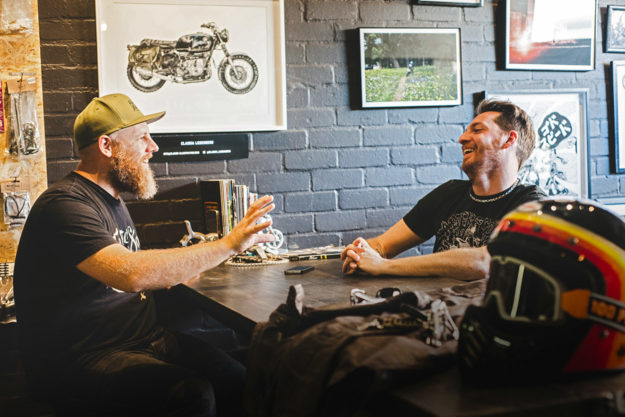
Cristian was in Cape Town for the launch of the new Yamaha MT-10 SP and TMAX—bikes that we’ll probably never cover here, but that he’s equally informed on and passionate about. We’d like to thank him for making the time to hang out and talk shop.
Yamaha Motor Europe | Facebook | Instagram | Interview photos by Devin Paisley